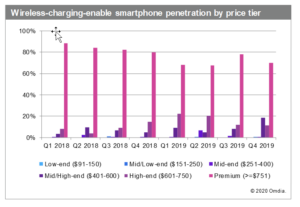Shipments of wireless-charging-enabled smartphones in the $401-to-$600 price range grew by 365 percent in the fourth quarter of 2019 as Apple’s price cut for the iPhone XR dramatically expanded the market, according to the latest findings from the Omdia Smartphone Model Market Tracker.
“The increase in wireless charging-enabled shipments in the $401-to-$600 price segment was triggered by Apple’s price reduction on the iPhone XR, which features wireless-charging capability,” said Anna Ahrens, senior analyst, smartphone and mobile, for Omdia. “After a $150 price cut in the fourth quarter, the iPhone XR dropped into the less-than-$600 price category. A total of 12 million wireless devices in this price tier are Apple devices, with 7.7 million iPhone XRs.”
Prior to the fourth quarter, more than 90 percent of phones with wireless charging capabilities were premium and high-end devices, with Apple’s and Samsung’s flagship phones commanding the majority of the share. However, in the fourth quarter of 2019, the portion of phones with wireless charging priced below $600 reached 18.8 percent at 16 million units, up from 4 million in the fourth quarter of 2018 and 6 million in the third quarter of 2019. In turn, the penetration rate for wireless charging-enabled smartphones within the $401-to-$600 price segment reached 58.7 percent, at 16 million units.
Still, wireless charging has not been a top priority for OEMs with phones priced at less than $600. OPPO, Vivo, as well as Samsung, for its mid-range phones, prefer camera innovations, battery performance, fast charging option or connectivity upgrades over wireless charging. Low charging efficiency, the additional cost for the wireless charger on the consumers’ side and the low valuation of wireless charging feature among Chinese consumers, hinder the wider adoption of wireless charging feature within those price tier. Therefore, it is unlikely that Apple entering this segment will change OEMs’ strategy and adoption of wireless charging.
Apple, Huawei and Samsung take the lead
In 2019, the overall share of smartphones with wireless charging grew 2.7 percent compared to 2018, reaching 18.5 percent. While this development is still positive, adoption growth slowed compared to the 5.6 percent annual growth from 2017 to 2018. This slowdown is attributed to a decline in wireless charging-enabled units in Samsung’s portfolio.
Within the same year, 165 million out of 195 million total iPhones were shipped with a wireless charging option. All iPhones released since the third quarter of 2017 have been equipped with this feature. Apple also has the highest penetration rate in its portfolio, reaching 94 percent in the fourth quarter of 2019.
Huawei unveiled its first wireless charging phone in the fourth quarter of 2018. By the fourth quarter of 2019, out of the 56 million Huawei smartphones shipped, 11 million were wireless charging-enabled. Globally, Huawei reached 12 percent share of the wireless charging market in the fourth quarter of 2019.
Samsung has equipped the premium Galaxy S, Note and Fold-series devices with wireless charging. However, the company’s focus on the mid–range A-series has resulted in a year-over-year decrease in the sales of the S-series, shrinking from 53 million in 2018 to 41 million in 2019. This shift is reflected in Samsung’s reduced market share and penetration rate for wireless charging smartphones in its portfolio and the overall market. 

